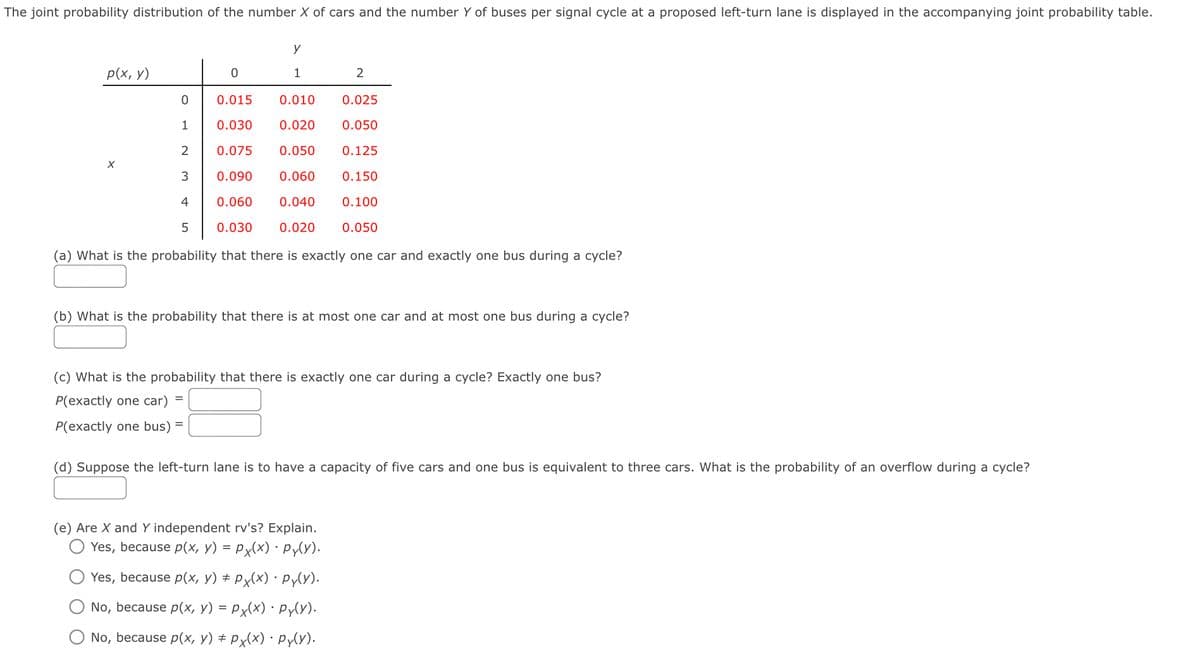The joint probability distribution of the number X of cars and the number Y of buses per signal cycle at a proposed left-turn lane is displayed in the accompanying joint probability table. p(x, y) 1 2 0.015 0.010 0.025 1 0.030 0.020 0.050 2 0.075 0.050 0.125 3 0.090 0.060 0.150 4 0.060 0.040 0.100 0.030 0.020 0.050 (a) What is the probability that there is exactly one car and exactly one bus during a cycle? (b) What is the probability that there is at most one car and at most one bus during a cycle? (c) What is the probability that there is exactly one car during a cycle? Exactly one bus? P(exactly one car) = P(exactly one bus) = (d) Suppose the left-turn lane is to have a capacity of five cars and one bus is equivalent to three cars. What is the probability of an overflow during a cycle? (e) Are X and Y independent rv's? Explain. O Yes, because p(x, y) = Px(x) • Py(Y). O Yes, because p(x, y) # Px(x) · PylY). O No, because p(x, y) = Px(x) Py(Y). O No, because p(x, y) # Py(x) Py(Y).
The joint probability distribution of the number X of cars and the number Y of buses per signal cycle at a proposed left-turn lane is displayed in the accompanying joint probability table. p(x, y) 1 2 0.015 0.010 0.025 1 0.030 0.020 0.050 2 0.075 0.050 0.125 3 0.090 0.060 0.150 4 0.060 0.040 0.100 0.030 0.020 0.050 (a) What is the probability that there is exactly one car and exactly one bus during a cycle? (b) What is the probability that there is at most one car and at most one bus during a cycle? (c) What is the probability that there is exactly one car during a cycle? Exactly one bus? P(exactly one car) = P(exactly one bus) = (d) Suppose the left-turn lane is to have a capacity of five cars and one bus is equivalent to three cars. What is the probability of an overflow during a cycle? (e) Are X and Y independent rv's? Explain. O Yes, because p(x, y) = Px(x) • Py(Y). O Yes, because p(x, y) # Px(x) · PylY). O No, because p(x, y) = Px(x) Py(Y). O No, because p(x, y) # Py(x) Py(Y).
College Algebra
7th Edition
ISBN:9781305115545
Author:James Stewart, Lothar Redlin, Saleem Watson
Publisher:James Stewart, Lothar Redlin, Saleem Watson
Chapter9: Counting And Probability
Section9.3: Binomial Probability
Problem 33E: Sick leave probability that a given worker at Dyno Nutrition Will call in sick on a Monday is 004....
Related questions
Question
I only need d) and e) thank you

Transcribed Image Text:The joint probability distribution of the number X of cars and the number Y of buses per signal cycle at a proposed left-turn lane is displayed in the accompanying joint probability table.
p(x, у)
1
2
0.015
0.010
0.025
1
0.030
0.020
0.050
2
0.075
0.050
0.125
3
0.090
0.060
0.150
4
0.060
0.040
0.100
0.030
0.020
0.050
(a) What is the probability that there
exactly one car and exactly one bus during a cycle?
(b) What is the probability that there is at most one car and at most one bus during a cycle?
(c) What is the probability that there is exactly one car during a cycle? Exactly one bus?
P(exactly one car)
P(exactly one bus) =
(d) Suppose the left-turn lane is to have a capacity of five cars and one bus is equivalent to three cars. What is the probability of an overflow during a cycle?
(e) Are X and Y independent rv's? Explain.
Yes, because p(x, y) = Px(x) · Py(y).
Yes, because p(x, y) ± Px(x) · py(y).
No, because p(x, y) = Px(x) · Py(Y).
No, because p(x, y) # Px(x) · Py(y).
Expert Solution
This question has been solved!
Explore an expertly crafted, step-by-step solution for a thorough understanding of key concepts.
This is a popular solution!
Trending now
This is a popular solution!
Step by step
Solved in 3 steps with 3 images

Recommended textbooks for you

College Algebra
Algebra
ISBN:
9781305115545
Author:
James Stewart, Lothar Redlin, Saleem Watson
Publisher:
Cengage Learning

College Algebra
Algebra
ISBN:
9781305115545
Author:
James Stewart, Lothar Redlin, Saleem Watson
Publisher:
Cengage Learning